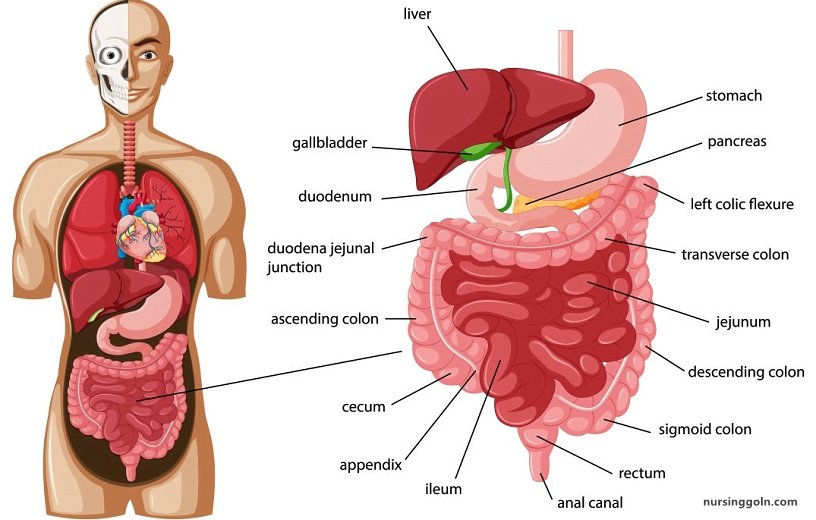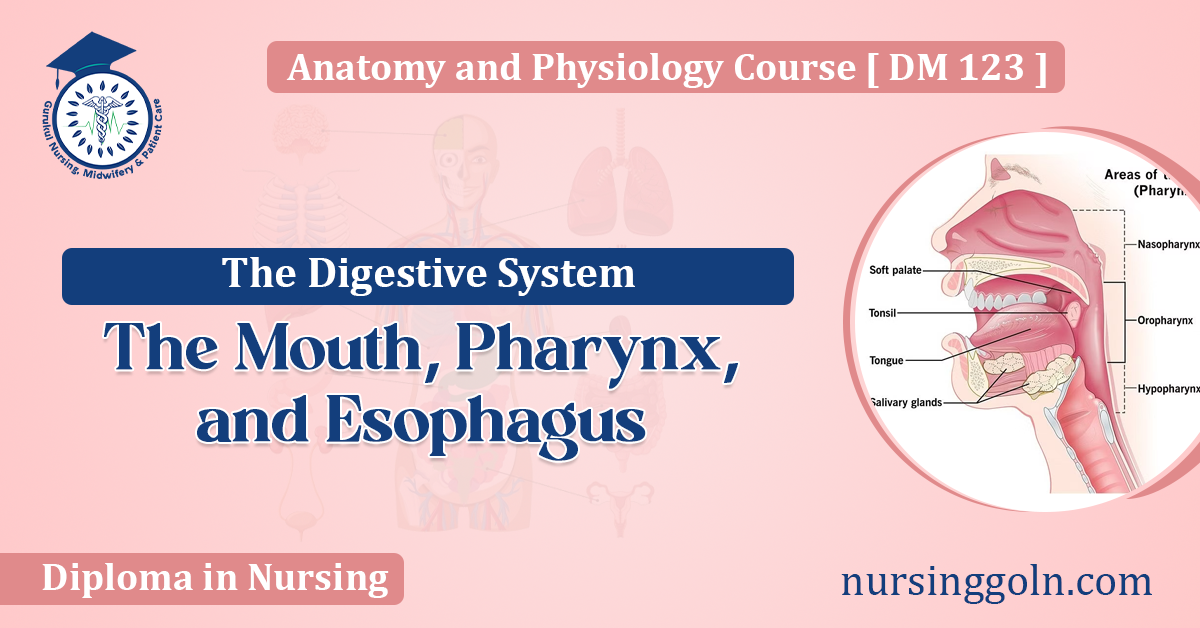Today our topic of discussion is ” The Mouth Pharynx and Esophagus “. The digestive system is a marvel of precision and efficiency, with each component playing a vital role in breaking down food and absorbing nutrients. Among the initial stages of digestion are the mouth, pharynx, and esophagus, which serve as the entry points for food and the beginning of a complex digestive journey. In this article, we will explore these integral components of the digestive system, examining their anatomy, functions, and the intricate processes that occur within them.
The Mouth Pharynx and Esophagus: The Digestive System

1. The Mouth: Where It All Begins
The mouth, or oral cavity, serves as the primary entry point for food and is the initial site of both mechanical and chemical digestion. Its role in digestion encompasses various functions that prepare food for further processing within the digestive system.
Anatomy of the Mouth
The mouth is comprised of several essential structures:
- Lips and Cheeks: The lips and cheeks form the boundaries of the oral cavity. The lips are highly sensitive and help guide food into the mouth. The cheeks contain muscles that assist in the process of chewing.
- Tongue: The tongue is a muscular organ responsible for several crucial functions, including manipulating food within the mouth, assisting in speech, and playing a key role in taste perception.
- Salivary Glands: Salivary glands, such as the parotid, submandibular, and sublingual glands, produce saliva. Saliva contains enzymes like amylase, which initiate the digestion of carbohydrates.
- Teeth: The mouth is equipped with teeth that mechanically break down food into smaller, more manageable particles. The different types of teeth include incisors, canines, premolars, and molars, each specialized for specific functions in the chewing process.
2. Mastication: The Chewing Process
Mechanical digestion in the mouth is predominantly accomplished through the process of mastication, which involves the crushing, grinding, and tearing of food into smaller pieces. The act of chewing:
- Reduces food into smaller, more manageable particles.
- Increases the surface area of food, facilitating the action of digestive enzymes.
- Mixes food with saliva, creating a semi-liquid mixture called chyme.

3. Chemical Digestion in the Mouth
Chemical digestion in the mouth begins with the secretion of saliva by the salivary glands. Saliva contains enzymes, the most important of which is amylase.
- Amylase: This enzyme initiates the breakdown of carbohydrates, specifically starches, into simpler sugars like maltose and dextrin.
4. Taste and the Role of the Tongue
The tongue, with its numerous taste buds, is central to the perception of taste. Taste buds are clusters of sensory cells located on the tongue’s papillae, allowing us to distinguish different tastes:
- Sweet: Associated with sugars and some artificial sweeteners.
- Sour: Associated with acids, such as citric acid.
- Salty: Associated with the taste of salt (sodium chloride).
- Bitter: Often linked to alkaloids, such as caffeine and quinine.
- Umami: Recognizes the taste of glutamate, present in foods like tomatoes and soy sauce.
The information transmitted from taste buds to the brain helps us differentiate between different types of food and contributes to our overall sensory experience of eating.

5. The Pharynx: A Common Passageway
The pharynx, commonly known as the throat, is a shared passageway for both food and air. Its role in the digestive system is brief but significant, as it serves as a junction where the path of food and the path of air are determined.
Anatomy of the Pharynx
The pharynx is divided into three regions:
- Nasopharynx: The uppermost part, located behind the nasal cavity. It serves as a passageway for air only and is separated from the oral and laryngeal pharynx by the soft palate.
- Oropharynx: Positioned behind the oral cavity, the oropharynx is the section where food and air paths cross. The palatine tonsils are situated in the oropharynx.
- Laryngopharynx: The lowermost portion of the pharynx, it connects to both the esophagus (for food) and the larynx (for air).

Deglutition: The Act of Swallowing
Swallowing, or deglutition, is a complex process that allows food to move from the mouth to the stomach while preventing it from entering the respiratory system. Deglutition consists of three phases:
- Voluntary Phase: The voluntary phase initiates the swallowing reflex, with the tongue pushing the food toward the back of the mouth and into the pharynx.
- Pharyngeal Phase: During this phase, the epiglottis, a flap-like structure, closes off the larynx to prevent food from entering the airway. The muscles of the pharynx contract to move the food into the esophagus.
- Esophageal Phase: The final phase involves peristaltic waves that move food through the esophagus and into the stomach.

6. The Esophagus: The Food Conveyor Belt
The esophagus is a muscular tube that serves as a conduit for food to travel from the pharynx to the stomach. Despite its seemingly straightforward role, the esophagus is a critical part of the digestive system.
Anatomy of the Esophagus
The esophagus is approximately 10 inches (25 cm) long and extends from the pharynx to the stomach. It consists of several layers, including:
- Mucosa: The innermost layer, which is responsible for the secretion of mucus to ease the passage of food.
- Submucosa: This layer contains blood vessels, lymphatic vessels, and nerve endings.
- Muscularis: The muscular layer consists of two types of muscle: smooth muscle in the upper third of the esophagus and both smooth and striated muscle in the lower two-thirds.
- Adventitia: The outermost layer of the esophagus that connects it to surrounding structures.
Peristalsis: The Force Behind Swallowing
Peristalsis, a coordinated series of muscular contractions, is crucial for the movement of food through the esophagus and into the stomach. When food enters the esophagus, a wave of muscular contraction propels it downward. Peristalsis continues until the food reaches the stomach.
Lower Esophageal Sphincter (LES): Guarding the Gateway to the Stomach
At the end of the esophagus, just before it connects to the stomach, is a muscular ring known as the lower esophageal sphincter (LES). The LES serves as a one-way valve that prevents stomach contents, including gastric acid, from flowing back into the esophagus.
Gastroesophageal Reflux Disease (GERD): A Common Esophageal Disorder
When the LES fails to function properly, it can lead to gastroesophageal reflux disease (GERD). In GERD, stomach acid flows back into the esophagus, causing irritation and inflammation of the esophageal lining. This can result in symptoms like heartburn and regurgitation, and if left untreated, it can lead to more severe complications.

The mouth, pharynx, and esophagus are the initial components of the digestive system, each playing a crucial role in the breakdown and passage of food. The mouth’s mechanical and chemical digestion prepares food for further processing, while the pharynx serves as a shared passageway for food and air, and the esophagus efficiently transports food to the stomach. These structures, though seemingly simple, are vital to the overall functioning of the digestive system, and any disruption in their processes can lead to digestive disorders and discomfort. Understanding their anatomy and functions is the first step in appreciating the intricate orchestration of the digestive system.
